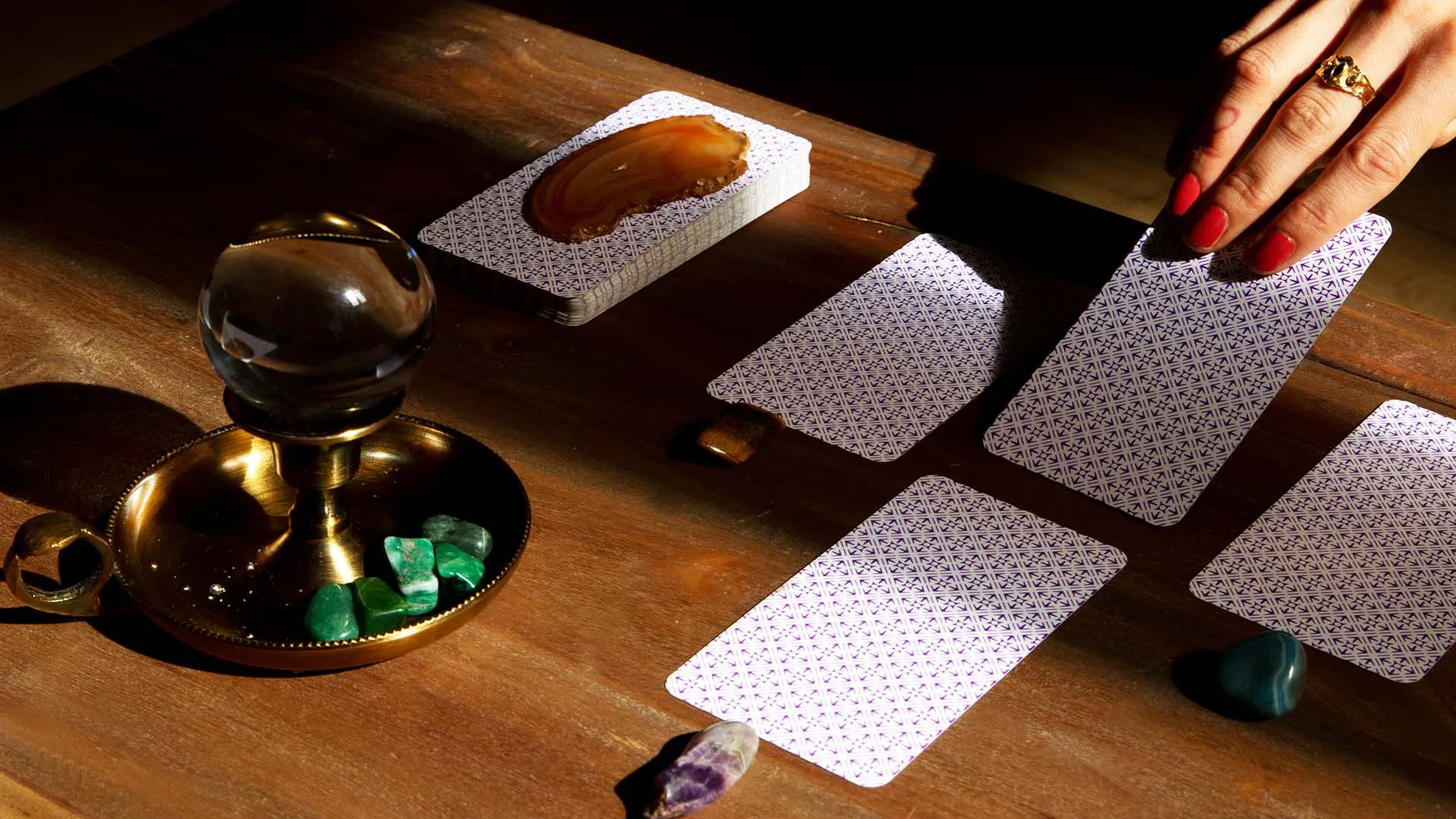Tarot cards are shrouded in mystery, so DailyOM spoke with professionals to understand what these cards can — and cannot — do, and how to get the most from a reading.
When you think of a tarot card reader, do you picture a kitschy psychic who comes to parties? A sleazy scammer at street fairs? As an avid tarot card reader myself, I’m grateful that this stigma is fading out, but for many people, questions and doubts still remain about tarot and whether the cards can see your future.
Below, experts provide clarity about where tarot cards get their power, what really happens during a reading, and how to set yourself up to get the best reading.
What Is Tarot?
Let’s start with the basics. Though tarot cards are thought of as future-telling devices, like a magical crystal ball, they are, in fact, tools that allow us to get in touch with our own truth. Don’t expect a tarot card reader to gaze at their cards and know exactly where you’ll be in a year or what you’ll be doing (or, for that matter, the winning lottery numbers).
Instead, as the experts explain, having a tarot card reading is an opportunity for you to focus on and work through issues you’re grappling with or questions you might have about your life and next steps.
Perhaps the reason why tarot cards are so misunderstood is because they have assumed many changes in their lifetime, as tarot reader Deborah Rossetto, located in Venice, Italy, tells DailyOM. “They have been paintings, they have been a court game, they have been esoteric objects and puzzles to be discovered,” Rossetto explains. “Today, they are also psychological tools for better understanding oneself.”
Interested in learning more? Check out The Art of Intuitive Tarot
Tarot History
Tarot wasn’t always used as the psychological self-help tool we know today. In fact, as Rebecca Delvey, a tarot reader from the Gold Coast, Australia, says, tarot cards didn’t even become a divination tool until the late 18th century.
“Tarot was originally known as trionfi, and later as tarocchi, and was used as the first playing cards in the 15th century,” explains Delvey, whom DailyOM spoke with for this story. “It was most popular in Italy, France, and Austria.”
With Rossetto’s help, we’ve compiled a brief timeline of tarot’s history below.
1414–1425, Italy
Painter Bonifacio Bembo created the first tarot deck in Italy for the noble Visconti family. It originally consisted of 66 oil-painted cards with gold embellishments. As Delvey mentions above, they were used for game play.
18th-Century Italy
The Tarot de Marseille — the very first deck to embody the traditional 78-card structure that we know today — was created in Milan, though tarot cards continued to be used for amusement rather than mystical purposes. Over the century, usage of the cards began to spread to France and Switzerland.
1909, England
This is when we began to see tarot cards used for divination purposes rather than for game play. After Tarot de Marseille gained popularity, occultists in England created the Rider-Waite Tarot Deck, the most popular and widely used deck to this day. This deck used the 78-card structure of the Tarot de Marseille and popularized it.
How to Prepare for Your Tarot Reading
The good news: Preparation is minimal!
First and foremost, lock down what you want your tarot reading to be about. Mainly, this includes seeking guidance or clarity on a particular situation or area of your life (e.g., love, career, what to do next with your life). Once you are working with a tarot reader, it’ll be up to you to draw conclusions, with their guidance and their understanding of the cards.
What to Expect During a Tarot Reading
“You can expect a number of cards to be drawn based on your question/topic/situation and the cards will bring you guidance, messages, and answers,” Delvey says. These “answers” aren’t ones that you are responsible for. The reader will draw narratives and conclusions for you based on the cards you’ve chosen together.
A tarot card reading can take anywhere from five minutes to one hour, depending on how many questions you have and who you’re working with.
You can choose to state your question directly to the reader or you can withhold that information. However, most tarot readers will prefer to understand an overall theme of what you'd like to discuss (think: love, career, family, etc.). If you’re looking for a more general reading, a tarot reader can work with that, too.
It’s important to note that this isn’t a prophetic process. As Rossetto explains, one should view a tarot reading as a “self-care practice” as opposed to a device that predicts your future. While many people think tarot will “give” them the answers, Rossetto says tarot is just a way to connect to the answers you have within yourself.
A tarot card reading allows us to dig deeper into our psychological blockages, find answers from our past, and help guide us forward.
Common Tarot Reading Methods
There is no single right way to do a tarot reading, Rossetto says. “Everyone has their own way, their own tradition, and culture.” For example, some readers allow clients to cut the deck or shuffle the cards, while others prefer to be the only one handling the cards.
“There are many ways to do a reading — either by chat, email, or face-to-face,” Rossetto says, and Zoom readings are increasingly popular, too.
While there are a few tried-and-true layouts — called “tarot spreads” — most tarot spreads are made in the moment, based on the questions you have. The reader will help you come up with a spread that answers your particular list of questions.
The Celtic Cross spread (outlined below) is probably the most popular tarot spread and the one that most people are familiar with.
The Celtic Cross Tarot Card Spread
- The situation
- Immediate challenge
- Distant past
- Recent past
- Best outcome
- Immediate future
- Factors affecting the situation
- External influences
- Hopes and fears
- Outcome
Are Tarot Cards Real and Accurate?
Ask this question of any professional tarot reader (myself included), and the answer you get will always be yes. Tarot cards are most definitely real and accurate.
That is because, as noted above, tarot cards are not a crystal ball. Rather, they act as a conduit to your innermost thoughts. Since the cards are there to help reveal your thoughts, including drawing out your subconscious ones, they can never be wrong. After all, they reflect your reality.
So, what happens if your tarot card reader pulls a card that seemingly has nothing to do with your situation? If this happens, it’s time to look at it from another perspective. It’s likely that the card may have an indirect message for the target question — or that it’s responding to a different query you have in your head.
As a reader myself, I’ve seen this happen many times. Say you’re pulling cards for your job trajectory. But as you shuffle, your mind wanders to your work crush. The cards that pop out may relate to love as opposed to career. If you draw a card that at first seems not to be relevant to your situation, sit with it for a while. You may discover there’s more there that is relevant than you first thought.
Can You Read Your Own Tarot Cards?
“You can absolutely read your own tarot cards!” says Delvey. Not only are tarot cards a fun way to tap into your intuition, but they can also help you identify certain aspects of yourself that your consciousness is blind to.
However, Delvey does suggest seeing a professional reader for more serious questions, as the situation may have more influence on your emotions. Remember the work crush example? Bringing in a third-party tarot reader eradicates most personal conflicts and distractions that can seep in when you’re reading for yourself.
How to Find a Tarot Card Reader
To find a reputable reader, Delvey suggests researching online tarot associations, which usually supply a list of legit readers, where you can find one who resonates with you. For example, Delvey is listed with the Certified Biddy Tarot Advisors.
If you’re hoping for a local reader, Delvey suggests starting at your local spiritual shop, as they typically have in-house readers come in.
However, there are also fantastic readers out there with no certifications and who do not read at local spiritual shops. You can ask around for recommendations from friends and family, and interview the tarot reader to see if you like their style. Have a little faith and trust your best judgment when picking a reader.
Tarot readers can be found both online and in person. However, there are scammers out there, says Rossetto. Here are some warning signs that the person you’re speaking with is not on the up-and-up:
- Reaching out to you on Instagram or Facebook. A real tarot reader will, of course, respond to your messages, but will never approach you first.
- Being pushy or becoming angry if you refuse a reading from them.
- Pushing you to spend more money in exchange for more information.
Always clarify the reader's fee and preferred payment process beforehand!
How to Read Tarot Cards for Yourself
For those who are completely new to tarot, Delvey provides an easy, step-by-step way to get started:
- Clear your mind and relax.
- Focus on the question or situation you want answers on or advice about.
- While focusing on the question, shuffle the cards.
- When you have finished shuffling (this will depend on when you “feel” that the cards have been shuffled long enough), pick your cards in accordance with the amount of questions you have. For example, if you have three questions, you will draw three cards—one for each question.
- Read them one by one, and receive your answer. Don’t worry if you are unfamiliar with the card meanings. Most decks come with a guidebook that can help you!
The Takeaway
Tarot reading isn’t a science. It is a personalized form of art, and a powerful way to get in touch with the path you want to take and answers to questions about everything from love to family to your professional life.
The best advice: Find a reader you trust, and then trust that they will do a good job. Or learn to read your own tarot cards and then be open to what the cards reflect back to you.

